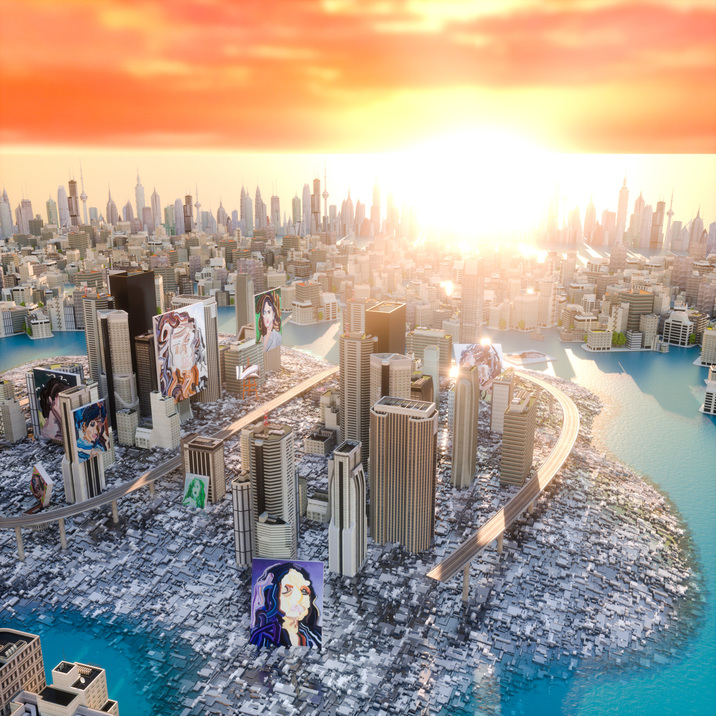-
From Current Issue
-
- Editor’s Letter Fire in the Heart
- Reviews I Gusti Ayu Kadek Murniasih
- Reviews 11th Seoul Mediacity Biennale: “One Escape at a Time”
- Dispatch Networked China
- One on One Monira Al Qadiri on Yukio Mishima
- Essays The rise of independent art spaces in pandemic-era Shanghai
- Features Tuan Andrew Nguyen
- Table of Contents
- Web Exclusives
- Archive
- Subscribe

R
E
V N
E
X
T
Screenshot of the virtual exhibition “Ding Li x Slime Machine,” 2020. All images courtesy the artists and MadeIn Gallery, Shanghai.
Curated by the Shanghai-based collective Slime Engine, the entrancing virtual show “Ding Li x Slime Engine” challenges conventional online exhibition models that blandly replicate physical spaces. The one-minute simulated tour presents Ding Li’s paintings, which remain untitled throughout, among a chimeric island and a futuristic city. Together with Ding’s abstracted portraits, the immersive artificial world possesses an uncanniness that elicits an unsettling familiarity: with facial features roughly mapped but not clearly sculpted and an urban city devoid of human life, the show captures the Freudian concept of “strangeness in the ordinary,” and, at the same time, the toxic impacts of urbanization.
The ethereality of the initial island scene contrasts with Ding’s expressive portraits. On screen, gradient shades of blue, purple, and pink bleed into a sunset. This serenity is quickly interrupted by Ding’s voluminous, organic brushstrokes. The painter creates caricatures of those around him, simultaneously obscuring their facial features and uniting these subjects with a common turbulent energy that evokes their inner turmoil, perhaps spurred by an uncertain future. The figures are cloaked in anonymity as the video quickly pans from one unknown, blurred face to another, emphasizing the collective psyche over that of the individual. This becomes more apparent as the island utopia fades into a gray, monotonous cityscape. Against a background of uniform, rigid arrangements, the indistinguishable faces by Ding insinuate the feeling of insignificance that city-dwellers often experience as people gradually lose their sense of self. The accompanying indistinctive white noise adds to this narrative of homogeneity often generated in urban settings due to the pressure to conform. The show calls attention to the depressing effects of metropolises, where concrete jungles dissipate personalities and individual identities.
The presentation also highlights the environmental ramifications of human development. As the landscape shifts from a deserted island to a city, Ding’s paintings remain the same, alluding to our voluntary paralysis and indifference when faced with the destructive processes of modernization. The magnified portraits placed at the top of the buildings correspond to the role of humans as the top predators of our ecosystem, decimating all life and replacing natural habitats with human-made cement. At the end, the video returns to the island, untouched by humankind, posing the possibility of an idyllic future where nature is conserved. Here, Ding’s portraits remind us of the impending dangers these picturesques face.
Slime Engine’s design for the online platform adds another layer to the meaning of Ding’s exhibited works. Viewers are supplied with a degree of control as they are able to adjust their perspectives with their cursors while on the predetermined tour path, acting as a mysterious entity that oversees the happenings of the world as a spectator. This is perhaps an allusion to the minority who recognize the detrimental impacts technology has on the environment, but at the same time are forced to remain participants in order to keep up with the pace of society. Viewers can also write comments, and see their anonymous messages projected over the virtual landscape in real time along with texts from other users. The interactive show encourages viewers to explore the landscape and connect with other audiences as a way to stimulate engagement and discussion, something that is much needed today.
The incorporation of Ding’s uncanny representations of humans into Slime Engine’s platform heightens the urgency and gravity of the hazardous consequences of urban and technological developments, as well as the exploitation of natural resources. Moreover, the presentation reconfigures the relationship between the viewer, the artwork, and the exhibition space, which may not have been possible with a white-cube setup. Through the employment of virtual reality and creative interface design, “Ding Li x Slime Engine” is a cinematic piece that lures viewers into its otherworldly realm, cautioning us against the predicaments of our own world.
Stephanie Siu is an editorial intern at ArtAsiaPacific.
“Ding Li x Slime Engine” is on view at the website of Slime Engine.
To read more of ArtAsiaPacific’s articles, visit our Digital Library.


















